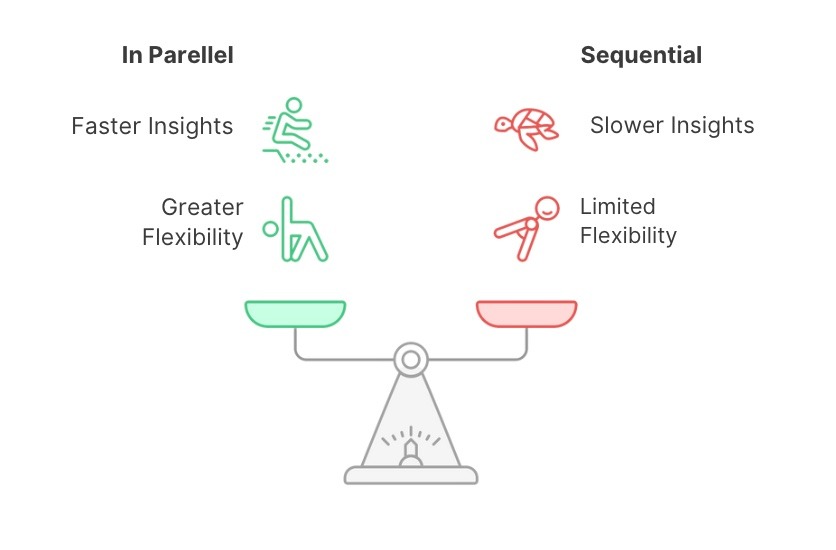In market and social research, there has been a long-standing divide between quantitative and qualitative approaches that is dissolving faster than ever. For decades, these disciplines lived in silos: quantitative research specialists dealt in numbers, statistical models, and large-scale surveys, while qualitative research practitioners immersed themselves in human stories, focus groups, and in-depth interviews. Each team uses its own tools, language, and pace, often working on the same business problem but from completely different angles.
Why 2025 Feels Different
In 2025, the reality has shifted. Now, clients expect speed and depth simultaneously and technology has made it possible by fusing data sources quickly. Now it is not only about asking “Should we combine both quant and qual?” it is more about why aren’t we doing it already?
When quant and qual work together it creates something more powerful than just the sum of their parts done separately. Quantitative research maps the landscape of what is happening, how big the pattern is and with what degree of confidence. While qualitative research explains the terrain about why people behave as they do, what drives their perceptions, and how context shapes their choices.
Numbers without stories can mislead just as stories without numbers can lack credibility. Combining both of them allows you to validate assumptions, cross-verify findings and uncover both trend and emotional forces driving it. Looking through both lenses doesn’t just make the report stronger, it also helps in reducing business risks by making sure decisions are based on facts and a real understanding of people.
The Myth That Mixing Methods Slows You Down
Some researchers worry that blending methods takes more time however in reality, the opposite is true when it is planned well. In today’s evolving research landscape a one-round of recruitment can power both phases, open-ended survey responses can be auto-coded into themes, and sentiment analysis can run in real time alongside statistical modelling. This means qual and quant can inform each other mid-stream, rather than waiting for separate studies to finish. This results in faster insights and greater flexibility to adapt when findings point in an unexpected direction.

What Happens When You Keep Them Apart
Keeping quant and qual separate comes with a hidden cost. Insights end up scattered, forcing stakeholders to piece things together on their own, which often leads to misunderstandings or leaning too heavily on just one point of view.
Separate teams also do duplicate work, extend timelines, and might even end up with conflicting conclusions which may delay decision-making. The lack of integration also misses key insights, a powerful story from a focus group could be overvalued and a strong survey results might overlook frustrations.
Real world Example
The value of integration is clear in recent projects. In June 2025, a mixed-method study for a cloud financial operations (FinOps) dashboard began with qualitative UX research to uncover practitioners’ biggest pain points. This was followed by a large-scale quant survey to measure how widespread each pain point was and to prioritize which features would have the greatest ROI. The combined approach not only shaped a clear product roadmap but also accelerated the development timeline, giving the client both the confidence of numbers and the nuance of real-world feedback.
Similarly, a global snack brand in 2024 used an agile hybrid process to test a new flavour: a survey revealed solid purchase intent but low excitement; two days of online focus groups identified exactly what was missing; and a revised concept retested in the same week saw purchase intent jump by 18%. These are the kinds of results that are only possible when quant and qual work in tandem.
A Researcher’s Perspective
As a market researcher, we should start with the question relevant to business needs rather than which method should be used. If the goal is to understand both the size of an opportunity and the reasons behind it, both qual and quant should be designed to work together rather than choosing between them. A researcher usually starts with quant “stem,” building the foundation on solid statistical analysis,and layers qualitative depth through in-depth interviews, digital ethnography, or thematically coded open-ended responses. The end deliverable shouldn’t be two separate decks but one integrated story where charts are brought to life with quotes, personas, journey maps, human voices are framed within validated, representative data.
So Are We All Generalists Now?

Not exactly. What’s happening in 2025 isn’t that every researcher must master every method but that we’re becoming T-shaped. Researchers today are expected to have broad fluency across quant and qual so that we can design and interpret hybrid studies and keep deep expertise in one core area. A quant specialist might learn enough interview skills to run a small focus group, and a qual expert might be comfortable designing a survey or reading statistical outputs. This balance ensures we can work seamlessly across both methods while still bringing specialist level value to the team.
At Q-Fi, we’ve built our entire approach around this philosophy. We believe insight should never live in silos. Our tools are designed to blend quant precision with qual depth in a single, seamless flow so that our clients can move from data to decisions with speed, confidence, and a complete understanding of the people behind the numbers.






.jpg)





%20(8).png)
.png)
%20(6).png)
.png)
.png)


